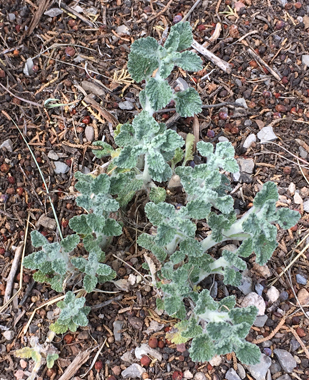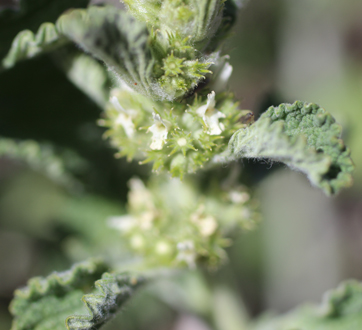
Location
Along the trail at #6 and at #9 under Pinion Pine (N35D33'02.237 X W105D41'22.878)
Flowers first observed: 5/22/17
The Plants

The Stem w/Flowers
Distribution
"Marrubium vulgare (white horehound or common horehound) is a flowering plant in the mint family (Lamiaceae), native to Europe, northern Africa, and southwestern and central Asia. It is also widely naturalized in many places, including most of Northand South America. (Wikipedia)
"Introduced to N. Amer., except Alberta, Manitoba, ND, LA and FL ; south to S. Amer.; throughout the world on every continent." (SEINet)
Description
"General: Perennial exotic herb from a taproot; stems several, prostrate to ascending-erect, 20-100 cm long/tall, densely white wooly. Leaves: Opposite, blades 1-6 cm long, conspicuously wrinkled, ovate to round, with crenate margins; generally green and pubescent above, white wooly below. Flowers: Whorled in globular clusters in leaf axils, with spiny calyces; corolla 5-10 mm long, whitish. Fruits: 4 nutlets." (SEINet)
Ethnobotanical Uses
Food:
"Diegueno Candy Infusion of leaves mixed with honey and made into candy. Navajo, Ramah Fodder Used for sheep feed, made the meat bitter." (Moerman 336)
Medicine:
"An old and revered bitter expectorant. Pour a pint of boiling water over one-half ounce or handful of the chopped plant, steep for ten minutes and drink during the day. It is bitter, so it can help to add several teaspoons of honey and a squeezed lemon or lime to the pint. It can be stored in the refrigerator during the day, one-half cup of the tea added to one-half cup hot water from the faucet for each cup. For coughs and lung congestion in general, a syrup is often preferable. ---Chronic use for extended lengths of time can have hypertensive effects, however, particularly in relation to arterial tension." (Moore 86)
Modern - Several modern scientific studies have been conducted on the usefulness of horehound. For example, a 2011 study concluded that the essential oil of M. vulgare contains potent antimicrobial and anticancer properties,[5] while a 2012 study found marrubiin, one of the primary active compounds found in horehound, to possess "antidiabetic, anti-atherogenic and anti-inflammatory properties".(Wikipedia)
"Cahuilla Kidney Aid Infusion of whole plant used for flushing the kidneys. Cherokee Breast Treatment Infusion used for 'breast complaints.' Costanoan ---Dermatological Aid Heated leaf salve used on boils. --- Isleta Antirheumatic (External) Poultice of crushed leaves used for swellings. ---Navajo, Ramah Analgesic Decoction of plant used for stomachache and influenza. ---Round Valley Indian Antidiarrheal Decoction of leaves taken for diarrhea." (Moerman 336)
Other Uses:
"A substitute for Hops in beer, still sold as Horehound Ale in Europe." (Moore 86)
"Horehound is used to make hard lozenge candies that are considered by folk medicine to aid digestion, soothe sore throats, and relieve inflammation.[7]
It is also used in beverages, such as horehound beer, steeped as tea (similar to the Maghrebi mint tea), and in the rock and ryecocktail.[8]" (Wikipedia)Internet Links
